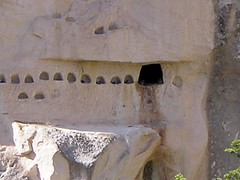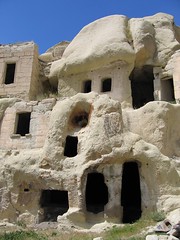
Edible Geography has an excellent post on the Li-Sun Exotic Mushroom Farm in Australia, which can serve as a good start to investigating what a large underground food production operation looks like.
Logistics: Li-Sun grows at least eight varieties of edible mushroom, and several varieties of medicinal mushrooms as well.
The tunnel for which these mushrooms have been so carefully developed is 650 metres long and about 30 metres deep. Buried under solid rock and deprived of the New South Wales sunshine, the temperature holds at a steady 15º Celsius. The fluorescent lights flick on at 5:30 a.m. every day, switching off again exactly 12 hours later. The humidity level fluctuates seasonally, and would reach an unacceptable aridity in the winter if Dr. Arrold didn’t wet the floors and run a fogger during the coldest months.
Based on the pictures of the racks they're using, it looks like you can fit ~84 mushroom logs per 5' square area devoted to growing, including room for walkways. It says logs are "made by mixing steamed bran or wheat, sawdust from thirty-year-old eucalyptus, and lime in a concrete mixer, packing it into plastic cylinders, and inoculating them with spawn", but for the sake of argument lets just say you'll be using some decaying vegetation from your nearby forest, used straw from your farmworkers' bedding, bat guano you collect from the pigeonholes your local bats roost in, and plenty of night soil from your growers and the other denizens of your subterranean community. The article also mentions that (at least in the case of Shiitake mushrooms, which he says are the most troublesome to grow) a log is crops after a week of exposure in the light, then goes dormant for about 3 weeks, then is productive again for 3-4 weeks. Let's imagine that every log produces half a pound of mushrooms over a productive week (I made that up, but its maybe believable). Thus, a single log of shiitake produces about 2 lbs of mushrooms over a 2-month-or-so span of time if my productivity guess is somewhere close to reality. Meaning a 5' square growing area produces around 20 lbs a week on average if it can be kept productive.
Of course, that space calculation only applies to growing space, which must receive light somehow for part of the day and be kept at the proper humidity. You'll also need a fully dark place to keep your dormant logs, but as these can be packed without regard for growing space and the logs are dormant for only 3/8 of the growing weeks, you can probably get by with 1/10 as much dark space as growing space, if you put in some nice shelving to keep things organized.
Of course, you'll also need a master mushroom grower and some obedient workers who can harvest the mushrooms, keep the floor properly wet, and rotate growing logs to and from the dark as appropriate. If you're using a humanoid tribe as your crew, your shaman or medicine man may already possess the requisite growing knowledge or be willing to learn it (otherwise you'll have to bring in an outside specialist, which is definitely going to cost you more of the profits). While your males form your war-party and go raiding, hunting, and trading, your females and younglings can be kept reasonably occupied tending the farm.
Economics: Not only are mushrooms a good food source, but some varieties have noteworthy medicinal, hallucinogenic, poisonous, or (depending on your locale) magical effects. You'll want to balance your growing operation to provide as much cheap food as possible for your growing crews and their families, while maximizing the trading possibilities for your surplus crop. Probably this means growing quite a few more edible mushrooms, but special mushrooms can bring a much higher premium for particular clients willing to pay for them. Here's a list of possible client preferences:

- Demonic cults will often be interested in hallucinogenic mushrooms for their ceremonies
- Assassins may be willing to pay a premium for particularly potent poisonous mushrooms, but you'll have to balance that against the dangers of growing them
- Wizards and witches often have need of particular mushrooms as spell components - at first these will probably be special orders but as you gain a sense of what varieties they require you can expand this part of your growing operation
- If your growers can function in complete darkness, they can grow so-called 'shriekers', which emit a high-pitched noise when light falls upon them. These are useful both around the perimeters of your community (where intruders using light are likely to trigger them, and as trade items for other dark-dwelling denizens.
- Check with your local sages or shamans to find out more about the local varieties available to you
Happy growing!






